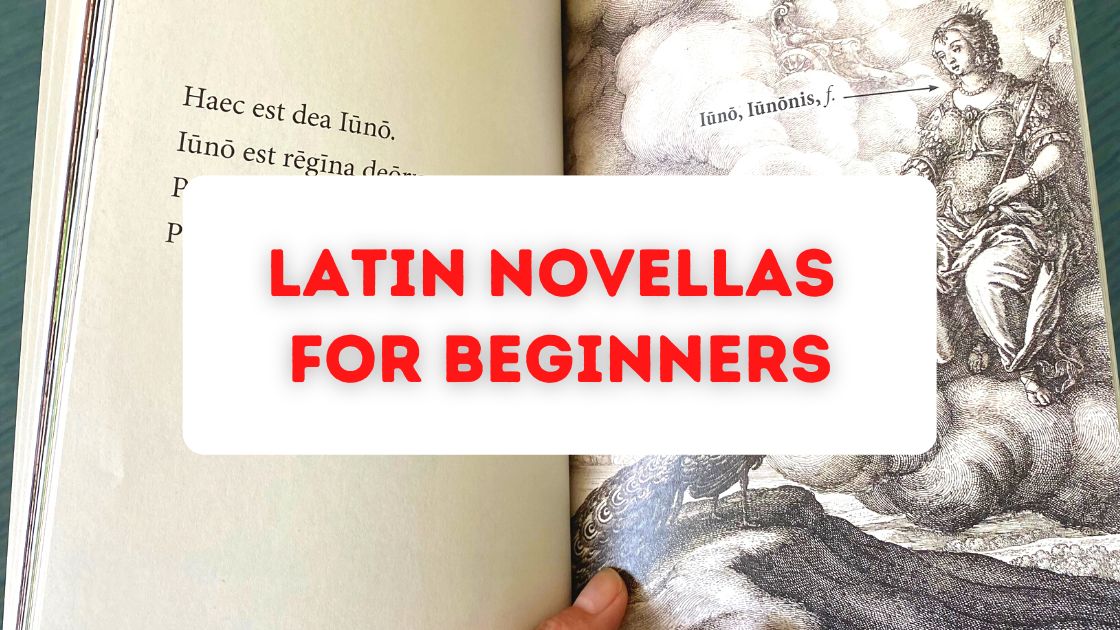12 Easy Latin Novellas for Beginners (Historical & Mythological)
Reading Latin is important, but what do you do if ancient texts are still too hard for you? Simple! You should read my favorite Latin novellas for beginners.
Second language acquisition researchers emphasize how crucial it is for language learners to read, read, and read some more. But you shouldn’t just read any old text: your reading material needs to be comprehensible for you.
In order to truly understand and effortlessly enjoy a story in Latin, you should know at least 95% of the vocabulary. This way you can read Latin quickly, like you read your native language. Your mind can absorb the input without translating it.
Latin novellas are a fantastic resource for Latin learners precisely because you do already know most of the vocabulary. You can read stories in Latin and improve your knowledge of the language while having fun.
In this post, I will list some of my favorite Latin novellas for beginning Latin learners. My students love novellas, and I hope you will, too!

This post may contain affiliate links and I may receive a commission, at no extra cost to you, if you make a purchase through a link. See my disclosures for more details.
Before we get to the list of novellas, let’s talk about what Latin novellas are and what principles they use. If you are already familiar with the concept of novellas, then you can jump down to the list itself!
What are Latin novellas?
Studying difficult texts, ones that challenge you or are a little too advanced for you, has a place in Latin studies. It is good to push yourself sometimes, but you should also read texts that are comprehensible to you.
Reading “comprehensible input” helps your mind to process Latin and form a mental model of the language. Even though you may not realize it, some of the most important language acquisition occurs as you read such easier texts.
Now here’s the problem. It is hard (often impossible) to find ancient Roman texts at appropriate levels for beginners. So what do we do? Latin novellas to the rescue!
In recent years Latin instructors have been writing more and more novellas aimed at beginning and intermediate students. These modern publications are a fantastic solution to the problem of comprehensible Latin reading materials.
How do Latin novellas work?
The basic principle is to “control” the vocabulary, that is, include only a certain number of unique Latin words (usually between 100 and 200). Any more difficult words are explained in the footnotes.
It is amazing what you can say with such limited vocabulary! Novella authors often rely on the Dickinson Latin Core Vocabulary for determining which words students already know, so check out that free resource if you have not already.
Latin novellas typically do not control grammar, with the result that more complex grammatical constructions may appear in simpler texts. This does not impact your understanding, though! You will be surprised how easily you understand new grammar as you read.
Novellas often have pictures to aid you in your comprehension. The goal is to understand in Latin without the need to translate into your native language, but there are also Latin-English word lists at the back to help you if you get stuck.
The novellas typically focus on a Greek or Roman myth or on life in ancient Rome, so you can learn more about classical culture and improve your Latin. It’s a win-win situation!
My Favorite Latin Novellas For Beginners
The novellas on this list are intended for students who are in their first year of Latin. If you are an independent learner, I would suggest waiting until you are through the first ten or so chapters of your textbook.
You likely won’t understand everything in each novella, but you will understand a lot. In the remainder of this post I talk about novellas that I particularly like and give tips on what they contain.
The following Latin novellas are arranged (roughly) in order of difficulty. When I mention the number of Latin words, I don’t mean the total number of words, but rather the number of unique words.
Ego, Polyphemus by Andrew Olimpi
Ego, Polyphēmus is a reimagining of Odysseus’ brush with the Cyclops . . . from the Cyclops’ perspective. Author Andrew Olimpi also includes the story of Polyphemus’ courtship of the nymph Galatea (and throws in some verses of Catullus).
Ego, Polyphēmus includes a vocabulary of only 140 unique Latin words and is primarily written in the present tense. This novella is perfect for beginning students: I started reading it with my class when we had finished Chapter 9 of Shelmerdine and they loved it.
Purchase Ego, Polyphēmus on Bookshop or Amazon.
Lars Romam Odit by Andrew Olimpi
Lars Rōmam Ōdit is a good historical option for beginning readers. Based (loosely) on Book II of Livy’s History of Rome, the novella gives us the perspective of Lars Porsenna.
Lars is the king of Clusium and due to an unwise alliance he is sucked into a war against Rome. He is a bumbling, but tyrannical, king, and students will appreciate his antics.
Lars Rōmam Ōdit contains less than 160 unique words and is primarily in the present tense. You can purchase this novella on Amazon.
Explore Latin: Avēs by Emma Vanderpool
This lovely book is part of Bolchazy-Carducci Publishers’ Explore Latin series. Explore Latin: Avēs introduces different birds in Latin and explains their relationship to the various Roman gods.
I love this book because it has over 40 stunning photos of birds and ancient artefacts. There isn’t as much text as in the other novellas, but this is a wonderful addition to your shelf nevertheless. You will learn bird names in Latin and you will be prepared to read the next book about augury.
Explore Latin: Avēs contains less than 100 distinct Latin words. You can purchase it on Amazon.

Augury is for the Birds by Emma Vanderpool
Augury Is For The Birds: Marcus dē Avibus Discit is another beautiful book from Emma Vanderpool. In this novella, we meet Marcus, a young boy who is training to be an augur but secretly wants to be a soldier.
Marcus pretends not to understand his teacher and hilarity ensues. You will learn a lot about Roman augury, so this is a good cultural / historical text. I absolutely adored this book and will definitely be reading it with my students in the future.
Augury Is For The Birds contains 144 unique Latin words. The action is in the present tense, but there are quite a few relative pronouns and present participles. The participles are explained in footnotes and there is also a grammatical guide at the back of the book.
You can purchase Augury Is For The Birds on Amazon.
Labyrinthus by Andrew Olimpi
Labyrinthus tells the story of Theseus and the Minotaur – from Ariadne’s perspective. Ariadne is a young woman just trying to deal with her family’s (literal) insanity. Her father is a wicked king, her mother fell in love with a bull, and her brother is half-bull, half-human.
When Theseus arrives, Ariadne decides to help him . . . but things go downhill from there. Labyrinthus contains 120 unique Latin words and is ideal for beginners. The narrative is primarily in the present tense, with some other tenses used occasionally.
You can purchase Labyrinthus on Bookshop or Amazon.
Sacri Pulli, Incitatus, and Surus by Emma Vanderpool
Are you a fan of Roman history and/or animals? Then you will appreciate Emma Vanderpool’s creative retellings of major Roman events.
Sacrī Pullī: A Tale of War and Chickens recounts the story of the sacred chickens who enraged a Roman general. The chickens convey the will of the gods, but not everyone supported them!
Incitātus: Fābula Equī Senātōriī takes place in Rome during the rule of the emperor Caligula. When Caligula makes his horse Incitatus a senator, chaos ensues (chaos that ends badly for the emperor).
Surus Elephantus tells the tale of Surus, the strongest elephant in the Carthaginian army. When Hannibal decides to march across the alps into Italy, Surus faces a challenge.

This trilogy gets gradually more difficult, with Sacrī Pullī being appropriate for beginning learners and Surus Elephantus being more suited for intermediate learners. I found these stories quite entertaining, but one caveat: one of the fonts used in some chapters is a bit difficult to read.
Ridiculi et Horribiles Dei et Deae by Rachel Beth Cunning
Do you like Greek mythology? Then this is a great novella for you! Rīdiculī et Horribilēs Deī et Deae is a collection of short stories about the lives of the Olympians. Topics range from the birth of Zeus to the abduction of Persephone.
According to the author, this novella is intended for use in Latin 1 or 2 and requires a working vocabulary of 154 words. Most verbs are in the present tense, but irregular verbs like sum, volō, nōlō, and eō appear frequently.
You can purchase this novella on Amazon.
Pandora by Andrew Olimpi
Pandora is one of my favorite Latin novellas. As you might expect from the name, Pandora – the first human woman – is the protagonist. Olimpi puts a twist on the original story: Pandora appears on earth and has no idea who she is.
We follow her as she wanders around earth and meets Circe before heading to Olympus in search of her creator, Vulcan. Olimpi weaves in other myths to great effect.
Pandora has 115 unique words and is told primarily in the imperfect and perfect tenses. There are also a lot of pronouns. This makes Pandora a little more difficult than the earlier novellas on this list; Olimpi calls it “beginning-intermediate.”
You can purchase Pandora on Bookshop or Amazon.
Via Periculosa by Andrew Olimpi
The last novella on this list is another favorite of mine. Via Perīculōsa is a (very loose) adaptation of a spooky episode from Petronius’ Satyricon.
Did you know that the ancient Romans told stories about werewolves? Well, now you do! Petronius describes a slave’s encounter with a shape-shifting soldier, and Olimpi has given us a version for novice readers of Latin. You may think you know what happens, but there is a twist at the end!
Via Perīculōsa is intended for beginning/intermediate students. It features 88 unique words and the action occurs in the imperfect and perfect tenses.
You can purchase Via Perīculōsa on Bookshop and Amazon.
Go Read Some Latin Novellas!
I hope that something on this list captured your interest. The novellas range from Emma Vanderpool’s historical stories to Andrew Olimpi’s mythological tales, so there is something for everyone.
Novellas are typically under $10 each, so you can purchase one and see what you think. Don’t underestimate the importance of reading extensively in Latin! Make novellas part of your studies.
You will feel so proud of yourself when you have finished your first novella in Latin. So go read!
And be sure to check out my tips for reading Latin fluently. This way you can be sure that you are getting the maximum benefit out of your new novellas!
YOU MAY ALSO LOVE:
My Favorite Latin-Learning Resources (Free & Paid)
Best Latin Dictionaries for Students




BA Latín Columbia College Class of 1985
I had no idea anyone ever started writing these.
All we had was Winnie Ille Pu
Hi David, thanks for stopping by! Yes, these Latin novellas are primarily a recent phenomenon. They are such a great addition to Latin learning materials 🙂
Pugio Bruti is over 300 unique words, so it seems to stand apart from this list. Possibly a candidate to be included on another though.
Hi John, you are absolutely right, and that’s why I didn’t include Pugio Bruti on this list. I need to make a post about intermediate/advanced novellas!